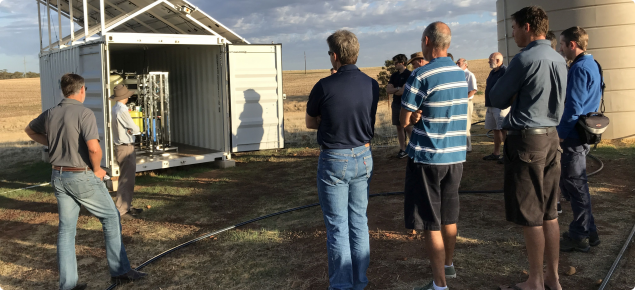Compliance with regulations
Disposal of saline reject water from desalination is covered by Soil and Land Conservation Regulations 1992, requiring owners or occupiers to notify the Commissioner of Soil and Land Conservation (Commissioner) before any discharge takes place. You must submit a notice of intent to drain or pump water – desalination (NOI), together with the neighbour comments, to the Commissioner of Soil and Land Conservation at least 90 days before intended discharge.
Note: Land degradation caused by operating a desalination plant is covered under the Soil and Land Conservation Act 1945, and could attract a Soil Conservation Notice.
Benefits of reverse osmosis systems on farms
Reverse osmosis (RO) desalinisation is a technology that farmers are now adopting, to improve water self-sufficiency when other sources are compromised, especially in low rainfall years or where better quality is required. The number of farmers seeking fresh water, and companies supplying units, have increased rapidly in recent drier than average seasons.
Most farms in the agricultural areas of Western Australia have bores into saline groundwater that could be suitable for RO desalination.
Will a reverse osmosis (RO) system suit you?
Conditions that would favour using an RO plant
- you have an urgent water deficiency
- you run out of water frequently
- your demand from the bore is less than 30kL/day
- you have bores producing brackish water
- water from off farm sources are limited or costs too much
- you have a safe place to dispose of the reject water.
Are your bores suitable for attaching an RO plant?
- Location: Ideally, bores should be able to sustain yields of greater than 30kL/day and be able to reject water safely to disposal points such as reject wells, evaporation basins, saline waterways and lakes. Bores high in the landscape into brackish aquifers can also use gravity to enable low-cost reticulation to tanks and disposal points.
- Salinity: RO plants require less energy and cost less to desalinate brackish water (< 8000mg/L). Salt water RO plants have different membranes, and can desalinate water up to 30 000mg/L.
- Sustained yield: Small RO plants using 10 to 30kL of water a day, and cost $20 000 to $40 000. Small units can be operated by solar photovoltaic panels, though most are single-phase grid connected. Larger RO plants producing 50 to 100kL of water a day cost significantly more, and require 3–phase power or stand-alone diesel generators. Note: effectiveness of solar systems will depend on the number of panels, orientation, and power storage.
- Other water quality factors: Water treatment is less complex for neutral acidity (pH), low silica and iron waters. Water chemistry will affect the efficiency of the RO membranes. Detailed water chemistry samples should be taken and analysed by an RO business.
Technical requirements of an RO plant
- The Commissioner must have no objection to the proposed reject water discharge before operating the RO plant. See Groundwater desalination and regulation for farm water supply in Western Australia, and use the right NOI.
- Have the power supply organised before installing the RO plant.
- We recommend that you obtain technical support before purchasing and operating the RO plant. RO plants need careful design, regular maintenance and planning for disposal of the reject water management systems.
Designing the system for desalination
We recommend that you take these steps
- Assess your water quantity and quality requirements, by ensuring the bores are located in the most suitable areas, with appropriate salinity and where the resource can be sustained.
- Test aquifer/bore yield by pumping, and analysing water chemistry through a reliable drilling or RO service, by pump-testing bores to ensure they are capable of meeting expected demand and ensuring water quality is acceptable. Pumping over an extended period of days to weeks may be required to confirm sustained yield and reliable water chemistry.
- Get quotes and basic designs from suppliers. Designs should include water sampling and assessment of reject water disposal options.
- There are several major suppliers, with some in Western Australia (WA) offering field and design services. Check that the supplier has experience in the WA grainbelt, knowledge of water chemistry and design issues, and provides maintenance and after-sales service.
- Assess disposal options – into purpose built reject bores, evaporation basins, creeks, salt lakes – before going to final design of the RO system. Complete a Notice of intent form, and submit it to the Commissioner of Soil and Land Conservation at least 90 days before the intended discharge. Add enough information for the Commissioner to properly assess the proposal, and to show that downstream neighbours have been fully advised. The proposal may be referred to other agencies and your Local Government for comment.
- Develop a final RO system design to confirm operability, power and disposal operations.
- Reassess the total costs of water from the RO system, and whether this is still your preferred option for additional water when compared to other options (eg rebuilding dams and roaded catchments).
- Order and install.
More information on desalination technologies
Membrane processes
- Reverse osmosis (RO). See American Membrane Technology Association for an explanation.
- Electrodialysis reversal (EDR). See American Membrane Technology Association for an explanation.
Thermal processes
- Multi stage flash distillation (MSF). See Wikipedia for an explanation.
- Multiple-effect distillation (MEF). See Wikipedia for an explanation.
- Vapour compression (METC, MVC). See Wikipedia for an explanation.
Ion exchange technology
- There are several ion exchange systems. See Wikipedia for a general explanation.

